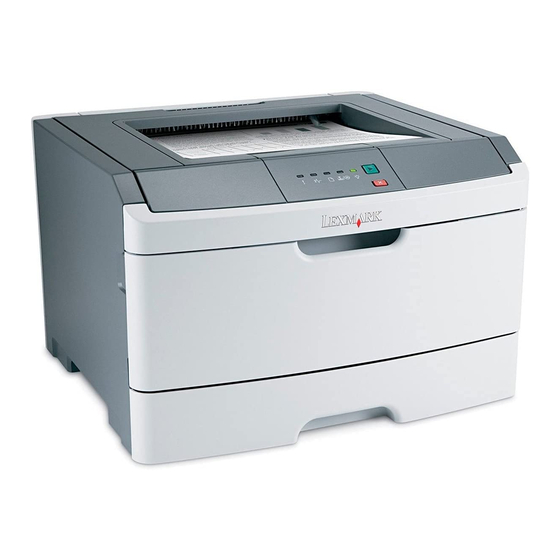Table of Contents
Advertisement
Quick Reference
Loading paper and
specialty media
This section explains how to load the 250- and 550-sheet trays, and
the manual feeder. It also includes information about setting the
Paper Size and Paper Type.
Setting the paper size and
paper type
Make sure the settings for the trays reflect the size and type of
paper loaded in the trays. The factory default paper type setting
is plain paper, so the paper type setting must be set manually for
all trays that do not contain plain paper. Access the Paper menu
through the Embedded Web Server if your printer is networked:
1
Type the printer IP address in the address field of your Web
browser.
Note: If you do not know the IP address of the printer, then
print a network setup page and locate the IP address in the
TCP/IP section.
2
Click Settings.
3
From the Paper menu, find the Size and Type for each input
source.
4
Select the paper size and paper type used most frequently from
each input source.
5
Click Submit.
If the printer is connected to a computer by a USB or parallel cable,
use one of the following utilities to access the Paper menu,
depending on your operating system:
•
On a Windows computer, access the Paper menu through the
Local Printer Settings Utility.
•
On a Macintosh computer, access the Paper menu through the
Printer Settings.
Note: The Paper Size and Type settings will be saved until you reset
factory default settings. If you would like to override the Paper Size
and Type settings for a special print job, do one of the following:
•
For Windows users, click File
Print, and then click
Properties, Preferences, Options, or Setup.
•
For Macintosh users, choose File > Print, and then adjust the
settings from the print dialog and pop-up menus.
Loading the standard 250-sheet
tray
The printer has two trays to select from: the standard tray (Tray 1),
also known as the 250-sheet tray, and either the optional
250-sheet tray or the optional 550-sheet tray (Tray 2). Only one
optional drawer (which includes an optional tray) may be attached
to the printer at one time.
Proper paper loading prevents jams and facilitates trouble-free
printing.
1
Pull the tray completely out.
Loading paper and specialty media
1
Do not remove trays while a job prints or when the Busy light
sequence appears on the printer control panel. Doing so may
cause a jam.
Busy
- On
2
Squeeze the width guide tabs, and then slide them to the sides
of the tray. The width guides move in unison.
3
Squeeze the length guide tabs together, and then slide the
length guide to the correct position for the paper size being
loaded.
If you are loading a longer size of paper like A4 or legal, squeeze
the length guide tabs and slide the length guide backwards to
Advertisement
Table of Contents

Summary of Contents for Lexmark E260d
-
Page 1: Quick Reference
Select the paper size and paper type used most frequently from each input source. Click Submit. If the printer is connected to a computer by a USB or parallel cable, use one of the following utilities to access the Paper menu, depending on your operating system: •... -
Page 2: Loading Paper And Specialty Media
the position for the length of paper you are loading. The tray extends backwards. If you are loading A6-size paper: Squeeze the length guide tabs together as shown, and slide the length guide toward the center of the tray to the A6 size position. -
Page 3: Using The Standard Exit Bin And Paper Stop
The manual feeder is located inside the manual feeder door of the printer and can feed only one sheet of paper at a time. You can use the manual feeder to quickly print on paper types or sizes that are not currently loaded in the tray. -
Page 4: Manual Feeder
Doing so may cause creases in the transparencies. • When moving the printer to another location, make sure the paper stop is closed. Paper capacities The capacities of the trays and the manual feeder are based on 75 (20 lb) paper. -
Page 5: Accessing Jam Areas
Store the paper in an appropriate environment. • Do not remove trays while the printer is printing. Wait for light to come on before removing a tray. The light sequence for loading paper also signals that the tray may be... - Page 6 202.yy Paper jam - On - On - On Open the front door, and then open the rear door. 231.yy Paper jam - On - Blinking - On Open the front door, and then open the rear door. 233.yy Paper jam - On - Blinking - Blinking...
-
Page 7: Clearing Jams Behind The Photoconductor Kit And Toner Cartridge
Close the front door. Press to continue printing. Clearing jams from the standard exit bin A duplex print job was sent to the printer using a paper size not supported for duplex printing. A sheet is jammed in the standard exit bin. -
Page 8: Clearing Jams In The Manual Feeder
To remove the jam, gently pull the sheet straight out of the standard exit bin. Clearing jams from Tray 1 To see whether paper is jammed in or behind Tray 1, the standard tray: Remove Tray 1. Remove the jammed paper. If necessary, depress the lever to free the paper and remove the jam. -
Page 9: Clearing Jams Behind The Rear Door
7. Clearing jams behind the rear door If the paper is exiting the printer, pull the paper out. If the paper is not exiting the printer: Push the release button, and then lower the front door Pull open the rear door.














Need help?
Do you have a question about the E260d and is the answer not in the manual?
Questions and answers